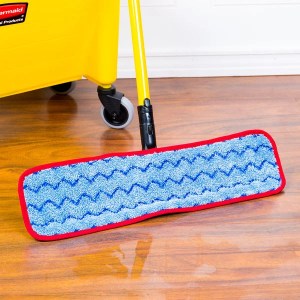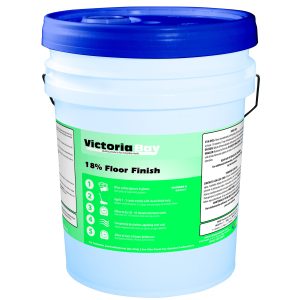Floorcare can be challenging, especially when performing a strip and wax. There are several steps as well as various mistakes that are common which can affect the outcome of the procedure.
Performing this restorative procedure is also time-consuming and expensive, so it is important to get it right the first time. However, given the time and labor it takes to perform this procedure, as well as the complexity of the process, there are often mistakes. This is largely due to untrained staff skipping steps and trying to consolidate or speed up the process.
To help make the process as seamless as possible for you and your staff, we put together a step-by-step guide on how to strip and wax a floor.
In addition to the 16 steps, we wrote a separate article that covers the 5 most common mistakes custodial staff make when stripping and waxing a floor.
Expert Tips For a Successful Floor Strip and Wax
Below, we offer 6 expert tips from industry-leading professionals so that your strip and wax procedure not only looks great in the end but goes smoothly and without any rework.
1. Work in Small Sections
Whether you are applying floor stripping chemical or a new coat of finish, work in 10 ft by 10 ft sections, or areas that are manageable for you.
Working in spaces that are too large is difficult and often leads to mistakes and poor outcomes.
This is especially important when applying the floor stripping solution. For best results, only apply stripping solution to an area that can be properly stripped within the next 20-25 minutes.
Working in manageable size areas allows you to remove the floor stripping solution while it is still wet. If the floor stripper dries on the floor before being removed, it can cause damage to the floor and make removing the dried finish extremely difficult to remove ultimately requiring additional steps. If you see the floor stripper starting to dry before you can fully remove it, apply more solution to keep the area wet until you can get to it.
It is also important to work in manageable areas during the finishing process.
When applying the finish, if you try to tackle too large of an area, this generally leads to an uneven application of the finish.
2. Always Dilute Your Floor Stripper to the Recommended Ratio
As directed by the chemical manufacturer, dilute the floor stripping chemical to the proper ratio. The right dilution is key to a successful striping procedure.
Both under-concentrated and over-concentrated solutions have their own potential negative effects.
An under-concentrated stripping solution will be too strong and can cause damage to your floor. In some cases, it can permanently bleach floor tiles.
While on the other hand, a solution with too much water and too little chemical will be ineffective. An overly diluted floor stripping solution will not remove old wax and will require your staff to repeat floor stripping procedures.
3. Use Cool Water to Prepare the Solution
When diluting your stripping solution, it is recommended to use cool water.
Hot water can be dangerous when diluting any chemical, especially harsh floor strippers.
In some cases, it can increase chemical odors, creating a hazard for employees and occupants.
Hot water also evaporates much more quickly causing the stripping solution to dry out too soon. We recommend working in small areas to avoid this.
Additionally, hot water has the potential to react with the stripping chemical and decrease the effectiveness of the chemical making it hard to remove layers of wax.
4. Line Your Mop Bucket With a Can Liner for Finish Application
The inside of your mop bucket can contain impurities and contaminants even if it has been thoroughly cleaned and dried.
Even the smallest impurities in a mop bucket can create big issues when applying fresh floor finish.
To prevent any soils from affecting the even application or damaging the color of your new floor finish, we recommend lining the inside of your mop bucket with a clean trash can liner before pouring in the finish.
Not only does this help to prevent any stray debris from contaminating your finish, it also allows for extremely easy clean-up. The liner can be discarded and the mop bucket returned to storage as long as there were no holes in the can liner, allowing the finish to leak into the bucket.
5. Use a Microfiber Flat Mop To Apply Finish
Use a clean, microfiber flat mop to apply the finish.

Cotton mops leave strings and lint behind in your finish. They also tend to absorb too much finish into their fibers making the application process extremely difficult.
While you can use a rayon or other synthetic fiber string mop, flat mops provide a more even application.
Additionally, flat mops are easier to handle and reduce the risk of getting finish on your molding and baseboard which could otherwise be frustrating, time-consuming, and difficult to remove.
6. Let The Finish Completely Cure

Depending on the thickness of the floor finish, and coats applied, dry time will vary.
However, it is critical to the outcome of the procedure that this last step is not rushed.
In general, we recommend blocking off the area and keeping foot traffic off of the floor for at least 8 hours after you’ve finished.
If you open the floor before the finish completely dries, occupants can track contaminants onto the floor which can get stuck in the finish.
You can use a fan to help circulate air in the area where the finish was applied. But, if a fan is used to expedite the drying time, make sure the fan is pointed up toward the ceiling only to move the air. It should not be pointed directly at the floor. This can create ripples in the newly applied finish.
Finally, the freshly set finish should not be buffed or burnished for a minimum of 24-48 hours after laying the last coat of finish. Trying to manipulate the finish before it is fully cured can completely distort or even remove the newly applied coats.
Final Thoughts
Stripping and waxing commercial hard floors is a complex procedure. It’s important to understand the steps as well as what you and your staff should avoid doing.
With these expert tips, plus our 16 step guide and mistakes to look out for, you and your cleaning team can strip and wax a floor seamlessly.
To learn more about how to build an effective hard floor care program specific to your facility’s needs, or to better understand the steps necessary to implement these procedures so you can keep your hard floors looking their best, contact a specialist today.
If you’re located in the United States, Puerto Rico, the Caribbean, or Canada, we can perform a free comprehensive review of your floor care program and identify any cleaning and maintenance gaps.
Request Your Floor Care Program Review Here
Imperial Dade locations also offer a hard floor care training course that will update you and your front-line staff on the latest processes and products to keep your floors looking their best.
